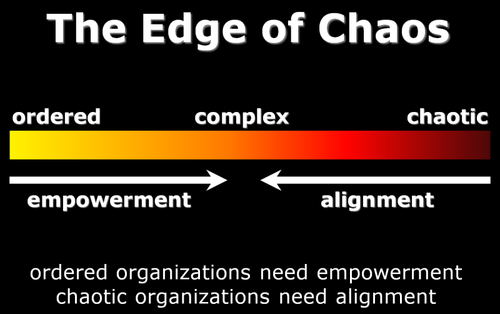In my little book How to Change the World I use the PDCA model to…
Management: A Deceptive Metaphor
The observation from scientists is that rules in a complex system must be tuned for the system to be both stabilizing, lively and creative. A different set of rules leads to a different system, with different behavior.
In an influential paper, Stephen Wolfram, founder of the first journal on complex systems and known for his work on Wolfram Alpha (a “computational knowledge engine”), once proposed a classification scheme which divided cellular automata (mathematical systems consisting of “cells” that can be “dead” or “alive”) into four categories:
- Class I: These are the systems with “doomsday rules”. No matter what pattern of living and dead cells you start out with, everything just dies within a few generations.
- Class II: These systems are a bit more lively, but not much. Each initial pattern quickly collapses to a set of very boring static configurations.
- Class III: These systems are at the opposite extreme: they are too lively. Each initial pattern in the system results in total chaos, with no configuration stabilizing and nothing being predictable.
- Class IV: These are the systems with a set of rules not leading to dead, static or chaotic configurations. Emerging patterns in this category are lively, creative, often surprising, but also stabilizing.
It should not surprise you that, in dynamical systems, class I and II correspond to order, class III corresponds to chaos, and class IV (of which the Game of Life is a famous example) corresponds to complexity. Given that complexity is usually explained as the region between order and chaos, this means that class IV finds itself between II and III. (This strange way of using numbers makes Wolfram’s computational knowledge engine all the more surprising.)
The same universality classification can be used (or should I say abused?) as a metaphor when distinguishing complex systems themselves. Take the human brain, for example. A class I brain would be dead: nothing happens in the brain. A class II brain could be comatose or catatonic: a state of silence or predictable repetitiveness. A class III brain could be insane or epileptic: displaying unpredictable and uncontrollable behavior. And finally, a class IV brain would be the only one considered lively and healthy. To prevent scientists from classifying my brain as a class III specimen, I must stress that I use this categorization only in metaphorical way.
When classifying organizations some people make a similar metaphorical distinction between ordered, chaotic, and complex organizations. (I assume you will forgive me for ignoring the dead organizations for now.)
- In ordered organizations no creativity and innovation are taking place. Nobody is empowered to make his own decisions. Bureaucracy dictates how all work is to be carried out, and fluctuations in organizational behavior are regular and predictable.
- In chaotic organizations there may be plenty of creativity, but not in a structured and predictable way. There is no emerging order in the organization, meaning that people simply empower themselves in getting things done. And everyone does as he or she pleases.
- Complex organizations find themselves right in between. In a complex organization, people cannot empower themselves. They are empowered by managers, who are faced with the challenge of finding a balance between empowerment and alignment, between self-organization and control.
It is said that a system at the balance between chaos and order, finds itself at the edge of chaos.
IMPORTANT: This classification of organizations is not scientific, but only a deceptively useful metaphor. I call it deceptive, because the metaphor has led some managers (including me) to conclude that they are responsible for finding the right balance between order and control. But as we shall see in some of my next blog posts, this conclusion is as common as it is wrong…
 Twitter –
Twitter –  Subscribe –
Subscribe –  Newsletter –
Newsletter –  Bookmarks
Bookmarks
|
|
Latest, greatest and favoritest posts: Self-Organization vs. Emergence Leader vs. Ruler: Which One Are You? The Complex Manifesto for Software Development |




